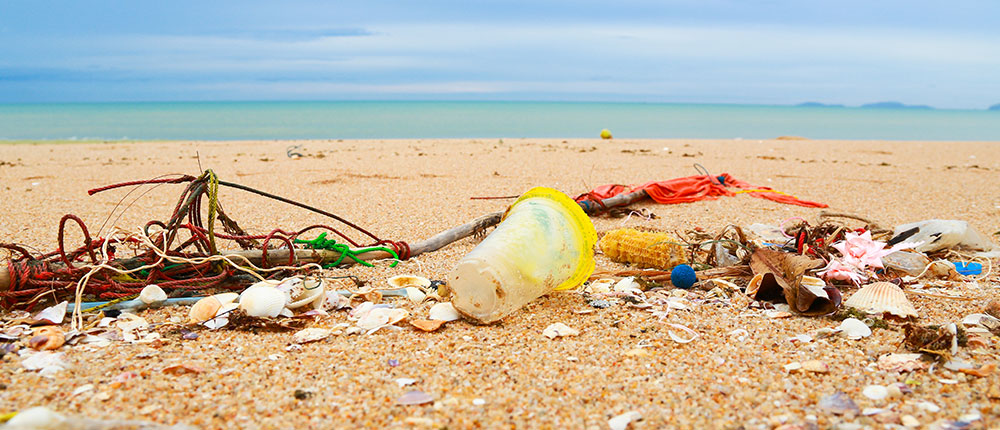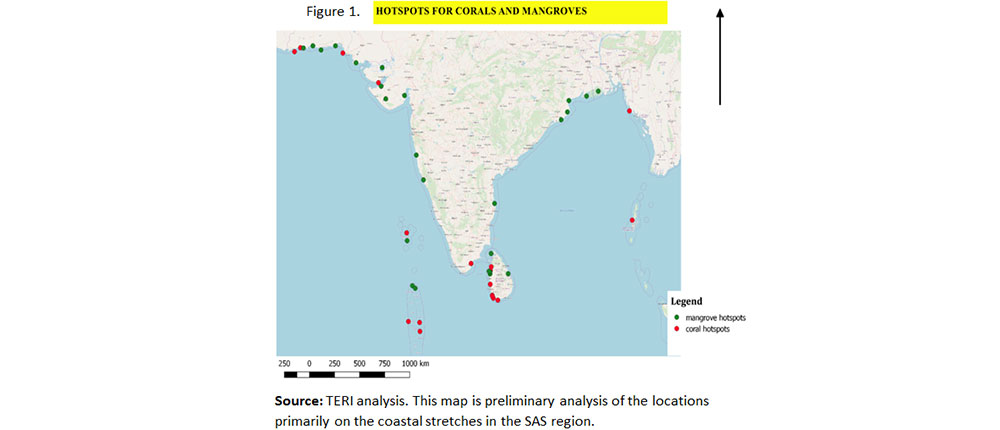
Oceans are the lifeline of planet Earth - they act as carbon sinks, absorb pollution and silt from rivers, regulate rainfall, act as nature reserves and support teeming sea life that provides food and livelihoods to many. About half of the world’s population lives within the coastal zone, and ocean-based businesses contribute more than $500 billion to the world’s economy (Protect Planet Ocean, 2010). South Asian Seas (SAS) region has only 4% of the world’s coastline, but it is unique and diverse in terms of its landscape, population size and density and culture.This region is particularly enriched with a variety of resources, and all these resources are highly endemic, which adds to their value and makes it even more important to conserve them.
Coastal populations of countries in SAS region are constantly expanding, also leading to increase in coastal pollution, making great demands for marine resources. There is growing evidence of further degradation of the marine environment and continued exploitation of living as well as non-living resources. This region is most densely populated in the world with an average 344 peoples per square kilometre. Dhaka has the highest density of 44,500 people per square kilometre followed by Mumbai with a population density of 31,400 people per square kilometre and Karachi with a population density of 2,400 people per square kilometre (SACEP 2017).
SAS countries - Bangladesh, India, Maldives, Pakistan and Sri Lanka are undertaking infrastructure development at different paces, which poses challenges in protecting and the conserving marine biodiversity due to the pollution that is generated at different levels and sources. Regional pollution sources can be categorised as solid waste from anthropogenic activities, sewage discharge, industrial effluents, mining, diffuse pollution from agriculture, nutrient pollution from aquaculture, marine trade and transport leading to oil spills, dredging and invasive fishing practices. Pollution in this region can be directly attributed to lack of proper sewage treatment, insufficient waste disposal and waste collection practices, lack of awareness and technology in local bodies and municipalities. In Bangladesh, India, Pakistan and Sri Lanka, only a fraction of the solid waste generated is collected; the rest ultimately finds its way into the ocean waters through rivers. Attribution to sources and pollutant management is difficult as regional information and linkages are not clear.
SAS region is rich in marine biodiversity - the figure below shows hotspots for corals and mangroves in this region. About 27% of world’s coral reefs are present here, which accounts for 250 species of corals. Corals act as direct sources of carbon sinks and are home to approximately 4,000 species of fishes. This accounts for 65% of fish species thus also helping to ensure food security. The coral-seaweed-herbivore triangle is an accepted generalization embedded within a highly complex web of biotic interactions and abiotic conditions, which enables sequestration of carbon through photosynthesis. Damage to corals impact not only species richness in this region but also threatens livelihoods and food security. This in turn can hamper development and growth of the SAS countries as loss of corals increases vulnerability of coastal cities and infrastructure to impacts of climate change.

There are about 80 different highly endemic species of mangroves in this region, which cover about 47 % of world's mangrove area (Kandasamy and Rajendran, 2005). Mangroves directly sequester carbon and exist in harmony with many endemic species. Anthropogenic pollution causes both habitat destruction and modification of mangrove ecosystems, which support important coastal fisheries and provide direct sustenance to coastal communities. As developing countries are more vulnerable to climate change, the SAS region cannot afford to lose mangroves as they act as natural sources of coastal protection and carbon sinks.
In the SAS region Chittagong, Colombo, Karachi, and Mumbai are major urban centres that impact coastal areas from activities like industries and tourism. These economic centres are expanding their industrial activities but lack technological implementation to treat pollutants in discharged effluents. Tourism plays a major role in marine pollution, by increasing sewage, plastic and other solid material in marine environment - a challenge arising from floating population (SACEP, 2017). Spin off activities like oil drilling for fuelling towns and cities, oil spills from shipping and ports from coastal development are a threat to marine biodiversity. Increasing population, development and urbanisation extends the challenge of pollution into marine waters directly and indirectly.
Over the years, agriculture has been intensified to meet growing needs of an increasing population. Increased use of Nitrogen and Phosphorus based fertilizers in agriculture results in eutrophication of the marine ecosystems. Another challenge is that the SAS region recognises very few Marine Protected Areas (MPAs) and these may not be properly managed. An assessment shows that the region’s MPAs included only 8% of its coral reefs in this region of which, only 1% were in effectively managed MPAs (Weeks and White, 2009, which was of particular concern. In the latter half of the last century, the region’s rich reef ecosystem was decimated to the extent that 11% collapsed and a further 48% was under a high threat of collapse within the next 20 years in the absence of management intervention (Wilkinson, 2004). The situation carried on into the new millennium with 88% under high risk (Weeks and White, 2009). Management response had some but limited effect, with evidence of increased public awareness and greater willingness for stakeholder participation. Scientific capacity for monitoring and assessment of reef health was firmly established. The policies applied to protect these areas are limited - one of the major challenges is the lack of a multilaterally recognised legal framework that may work to protect these highly valuable seas.
Therefore one can conclude that the SAS region is plagued by multiple challenges that include – (i) pollution from urban areas including sewage, solid waste and plastics; (ii) industrial pollution including chemicals, nutrients and warm water; (iii) agriculture runoff including nutrients and pesticides; (iv) climate change and warming of oceans; (v) oil spills, dredging of ocean floors, improper fishing mechanisms; and (vi) inadequate regional cooperation mechanism and marine protected areas and unavailability of data. Clearly, there is a need for a regional programme that brings together relevant SAS countries, and if needed, then others like Chagos, Madagascar and Indonesia to manage pollution through policy, planning, technology and hotspot management; and create appropriate regional cooperation mechanisms.
References
- IUCN (2010) Protect Planet Ocean Now, Available at: https://www.iucn.org/content/protect-planet-ocean-now
- SACEP (2017) Marine Environmental Pollution: Challenges & Opportunities in the SAS region, Available at: http://www.sacep.org/pdf/Reports-Technical/2017.05-Marine-Environment-Pollution-Challenges-and-Opportunities-in-South-Asian-Seas-Region.pdf
- Weeks and White (2009) Marine Protected Areas in the Coral Triangle: Progress, Issues, and Options, Available at: https://www.researchgate.net/publication/38024117_Effectiveness_of_Marine_Protected_Areas_in_the_Philippines_for_Biodiversity_Conservation
- Wilkinson, ICRI Forum (2004) Status of Global Coral Reefs , Available at: https://www.icriforum.org/sites/default/files/scr2004v1-all.pdf
- Kandasamy and Rajendran (2005) Mangrove ecosystem of the Indian Ocean Region, Available at: http://www.researchgate.net/publication/254434299
